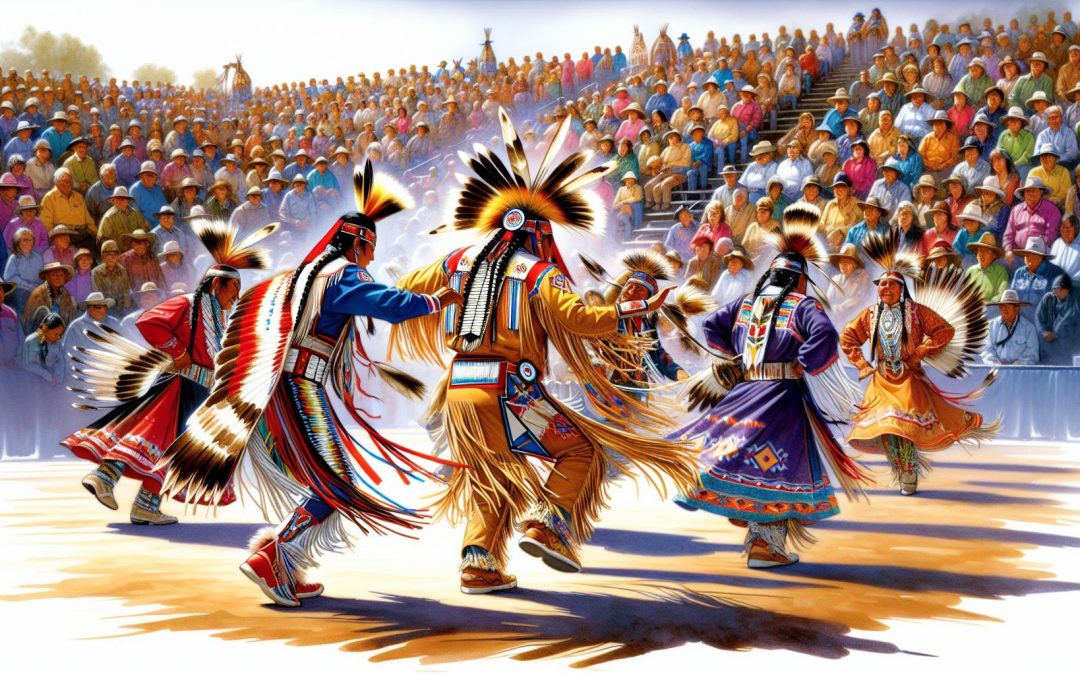Growing up, I always found myself mesmerized by the rich tapestry of Native American culture, especially the vibrant celebrations that bring communities together. It wasn’t until I moved to Scottsdale, Arizona, that I got to experience the true essence of these gatherings. Here, Native American powwows and gatherings aren’t just events; they’re a profound expression of heritage, unity, and storytelling that continues to thrive in the heart of the desert.
Every year, Scottsdale becomes a pulsating hub for these cultural festivities, drawing in crowds from all walks of life. The powwows, with their spectacular dance competitions, traditional music, and colorful regalia, offer a unique window into the soul of Native American traditions. It’s a world where every step and every beat tells a story, inviting us to listen and learn. Join me as I share my journey into the heart of these gatherings, a journey that’s as enlightening as it is exhilarating.
The Significance of Native American Powwows and Gatherings
Exploring the depth of Native American powwows and gatherings, especially in Scottsdale, has been an enlightening part of my journey. These events aren’t just about vibrant displays of culture; they’re pivotal in preserving the rich heritage of Native American communities. I’ve learned that each powwow and gathering serves as a living museum, showcasing the traditions that have been passed down through generations.
One aspect that stands out is the storytelling. These gatherings are a platform for oral histories to be shared, connecting attendees with the past in a powerful way. Stories of triumph, survival, and the profound connection to the land are told with pride and passion. This storytelling acts as a bridge, linking the old with the new, ensuring that the essence of Native American culture remains vibrant and relevant.
Another significant element is the sense of unity these events foster. Regardless of one’s background, everyone is welcomed with open arms. This inclusivity strengthens community bonds and promotes a spirit of togetherness. It’s heartwarming to see people from various walks of life come together, celebrating the beauty of diverse cultures united in harmony.
The dance competitions are another highlight. Dancers, adorned in meticulously crafted regalia, compete not just for prizes but to honor their ancestors and share their culture’s beauty. Each step and movement tells a story, embodying the dancers’ heritage and personal journeys. These competitions are more than a display of talent; they are a testament to the resilience and enduring spirit of Native American cultures.
Lastly, these powwows and gatherings play a crucial role in educating others. Through music, dance, and art, attendees gain a deeper appreciation for and understanding of Native American histories and ways of life. It’s a privilege to witness these traditions firsthand, offering a unique perspective that books and museums can’t replicate.
In Scottsdale, these gatherings are a testament to the enduring strength and richness of Native American culture. They’re not only a celebration of heritage but also a significant means of cultural preservation and community building.
A Guide to Scottsdale’s Most Notable Powwows

As I continue my journey through the vibrant world of Native American powwows and gatherings in Scottsdale, Arizona, I’ve come across several notable events that stand out for their cultural significance and community engagement. These gatherings aren’t just about the spectacle; they’re deeply rooted in the traditions, stories, and unity of Native American communities. Here, I’ll share a few of Scottsdale’s most notable powwows, each offering a unique experience for attendees.
- Orme Dam Victory Days Celebration: Held annually in November, this powwow commemorates the victory against the construction of the Orme Dam, which would have flooded the lands of the Fort McDowell Yavapai Nation. Participants can expect traditional dances, music, and mouthwatering frybread, alongside a thrilling All-Indian Rodeo.
- Red Mountain Eagle Powwow: Taking place at the Salt River Pima-Maricopa Indian Community, the Red Mountain Eagle Powwow is a must-see for its grand parade, dance competitions, and artisan market. It’s a splendid opportunity to witness the incredible talent of Native American dancers and to purchase authentic crafts.
- Scottsdale Community College Powwow: This event, typically held in April, emphasizes education and cultural exchange. As a smaller, more intimate gathering, it allows for personal interactions with dancers, artists, and storytellers. It’s an ideal setting for those seeking to deepen their understanding of Native American cultures.
These powwows in Scottsdale invite not only the local community but also visitors from around the globe to partake in and appreciate the rich tapestry of Native American heritage. Through vibrant dances, compelling storytelling, and the sharing of traditions, attendees leave with a greater appreciation for the history, resilience, and beauty of Native American cultures. As I immerse myself in these gatherings, I’m reminded of the vital role they play in cultural preservation, education, and fostering a sense of community. Whether you’re drawn to the competitive dance, the exquisite artistry, or the chance to participate in a communal celebration of heritage, Scottsdale’s powwows offer a welcoming space to connect and learn.
What to Expect at a Powwow in Scottsdale

Attending a powwow in Scottsdale, I find myself immersed in the vibrant heartbeat of Native American culture. These gatherings, rich in tradition and communal spirit, offer an array of experiences to both novices and seasoned attendees alike. Here, I’ll guide you through what to expect at these extraordinary events.
First off, traditional dances take center stage. Dancers in colorful regalia perform intricate steps passed down through generations, each movement telling a story or symbolizing a prayer. From the energetic Fancy Dance to the solemn Grass Dance, witnessing these performances feels like stepping into a living tapestry of Native American history.
Music plays a crucial role, with the stirring beat of drums and the haunting melody of flutes forming the soundtrack of the powwow. Drum groups, often family or clan-based, provide the rhythmic foundation that drives the dancers’ movements, encapsulating the powwow’s soul-stirring essence.
Storytelling and oral traditions hold a place of honor, offering attendees a glimpse into the rich narratives that define Native American cultures. Elders share tales and wisdom, bridging the past with the present and enriching the powwow experience with layers of meaning.
Artisan markets tantalize with a bounty of handcrafted goods, from intricate beadwork and pottery to stunning jewelry and traditional attire. Each piece reflects the artists’ skills and cultural heritage, making them not just souvenirs, but treasures that carry the spirit of the powwow home.
Yet, what truly sets these gatherings apart is the palpable sense of community. Everyone, regardless of background, is welcomed with open arms into a space that celebrates unity, respect, and the enduring strength of Native American cultures. Here in Scottsdale, the powwow isn’t just an event; it’s a profound communal experience that stays with you long after the last drumbeat fades.
Etiquette and Tips for Attending Powwows
Understanding the cultural richness and significance of Native American powwows in Scottsdale, it’s essential to discuss how attendees, especially those new to such gatherings, can respect and honor these traditions. Here, I’ll share some key etiquette guidelines and tips to ensure you enjoy and respect powwows fully.
Dress Appropriately
Remember, powwows are significant cultural events. Wearing modest and respectful clothing is a must. Avoid anything too revealing or with culturally insensitive prints. Opting for comfortable shoes is wise too, since you’ll likely be on your feet for a good part of the event.
Photography Guidelines
Not all moments at a powwow are meant to be captured on camera. Always ask for permission before taking photos or videos, especially of the dancers and their regalia. Some moments are considered sacred, and photography might be prohibited.
Participate Respectfully
When invited to join a dance, it’s a sign of honor. However, it’s crucial to follow the lead of others and not to mimic or mock the movements. If you’re unsure about participating, it’s perfectly okay to watch and appreciate from the sidelines.
Food and Artisan Market Etiquette
Supporting Native American artisans and food vendors is a fantastic part of attending powwows. Be sure to handle crafts with care and respect the value of the work by not haggling over prices. When trying traditional foods, embrace the experience with an open mind and heart.
Show Respect to Elders
Elders hold a place of great respect in Native American cultures. Offering them your seat if seating is limited, listening when they speak, and not interrupting are simple ways to show your respect.
By following these guidelines, you’ll not only enrich your experience at Native American powwows in Scottsdale but also ensure you’re contributing positively to the preservation of these essential cultural gatherings.
The Cultural Impact of Powwows in Scottsdale
Following the etiquette guidelines and participating respectfully in activities enhances the overall experience at Native American powwows in Scottsdale. My exploration of these gatherings illuminates how they significantly impact the local community and visitors, enriching Scottsdale’s cultural landscape.
Firstly, these events cultivate a deeper understanding and appreciation for Native American traditions among attendees. Through engaging with dances, music, storytelling, and artisan markets, people of all ages learn about the vast histories and cultures of Native American tribes in a vibrant and interactive manner. This educational aspect strengthens cultural awareness and bridges gaps between communities.
Moreover, powwows in Scottsdale serve as crucial platforms for Native American artists and craftspeople to showcase and sell their work. Artisans from various tribes display jewelry, pottery, textiles, and other handcrafted items, providing them with essential economic opportunities. The exposure benefits not only the artists but also enriches the diversity of cultural offerings available to Scottsdale residents and visitors.
Community spirit thrives at these gatherings, fostering a sense of unity and celebration among participants and spectators alike. The shared experiences at powwows, such as joining in dances or enjoying traditional foods, contribute to a stronger community bond. This increased cohesion benefits Scottsdale by encouraging inclusivity and mutual respect among its diverse populations.
Lastly, Scottsdale’s powwows play a pivotal role in preserving Native American heritage. Each event acts as a living museum, safeguarding traditions for future generations. The dedication to preserving these cultural expressions ensures that they remain a vibrant part of Scottsdale’s identity, enriching the city’s cultural fabric for years to come.
The cultural impact of powwows in Scottsdale extends far beyond a single event. They educate, connect, and inspire, weaving the rich tapestry of Native American culture into the broader community. As I delve deeper into the significance of these gatherings, it’s clear they embody much more than tradition—they represent resilience, celebration, and shared humanity.
Conclusion
Attending a Native American powwow in Scottsdale isn’t just an event; it’s a journey into the heart of a vibrant culture that’s been thriving for centuries. I’ve always believed in the power of experiences to bridge gaps and build understanding, and these gatherings do just that. They’re a celebration of life, history, and community that speaks volumes to both the spirit and resilience of Native American peoples. Whether you’re drawn by the mesmerizing dances, the compelling music, or the exquisite art, you’ll leave with a deeper appreciation for the rich cultural tapestry that these events weave into our lives. So, if you ever get the chance, I highly recommend you immerse yourself in this extraordinary experience. It’s not just about witnessing tradition; it’s about connecting with a community and perhaps, in the process, discovering a part of yourself.







